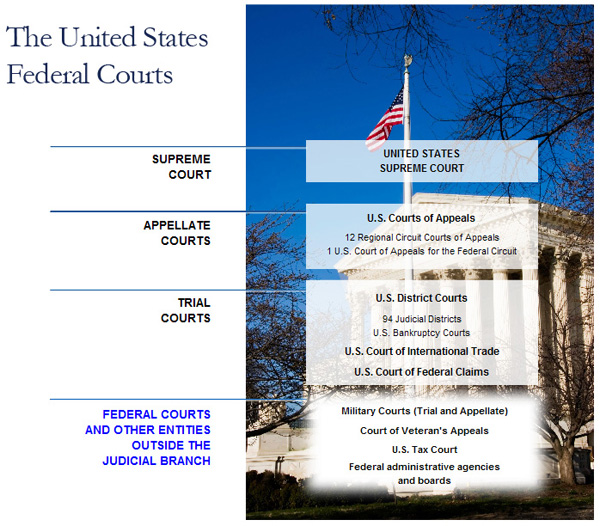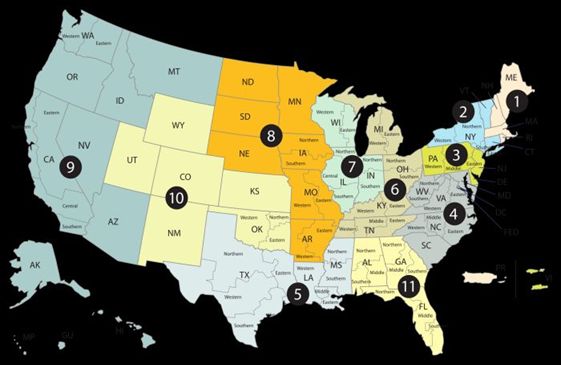Learn
|
The United States court system plays a vital role in protecting your civil rights and liberties. Understanding its function is an important part of your responsibility as a citizen. In fact, if you are eighteen years of age and a citizen of the United States, you may even become involved in the court system yourself, as a member of a jury in a federal district court! "We the people" must follow certain procedures to have a case heard by the federal courts due to the structure and organization of the court system. As we learned in the previous lesson, our judicial branch is comprised of two court systems: federal and state. The federal court system deals with the constitutionality of a law. The state court system can deal with anything from criminal cases to family law cases. In this lesson you will learn the structure and organization of the federal courts. The Judiciary Act of 1789 created a three-tiered structure for the federal court system that includes:
Structure of District CourtsThe District Courts are the trial courts of the federal court system. They are also known as the lower courts because they are the starting point for cases dealing with federal statutes or the Constitution. There are 94 federal judicial districts with at least one in every state, one in Washington D.C. and Puerto Rico, and three more in U.S. territories. District courts are the only federal courts that have jury trials. Each district court also has at least one District Judge who is appointed by the President and confirmed by the Senate. There are about 670 district court judges. These judges have no defined terms and may serve in their appointed positions for life. In addition, each district court has a magistrate who issues court orders and hears evidence to determine if a case should be brought to trial. Read About Federal District Courts: Court Role and Structure to learn more about the structure and role of the Federal District Courts. Structure of Federal Courts of AppealsThe Circuit Courts of Appeal are also known as the higher courts because they are a tier above the district courts. The 94 judicial districts of the federal court system are organized into 12 regional circuits. Each of the twelve circuits has a Court of Appeals that hears appeals from district courts in its geographic circuit. There is also one Court of Appeals for the Federal Circuit that hears specialized cases, including cases involving international trade and patent laws. The Supreme Court is the final level of appeal.
Federal courts have limited jurisdiction since they can only decide cases involving the Constitution, federal laws, and disputes between states or the U.S. and a foreign government. District Courts have original jurisdiction, or the authority to be the first to hear a case, in both civil and criminal federal cases. Civil cases involve private rights of individuals or groups and often include disputes over money or property. Criminal cases involve breaking the law and include income tax evasion, bank robbery, kidnapping, and mail fraud. Circuit Courts only have appellate jurisdiction, or the authority to hear only cases appealed from lower district courts or federal agencies, since they were transformed by the Judiciary Act of 1891. Read Jurisdiction of the Federal Courts to learn more about federal court jurisdiction. Read Court Role and Structure. Read Federal Courts and the Public. Search the Federal court locator to locate the state of Alabama. Notice that the state is divided into three federal court districts: the U.S. District Court for the Northern District of Alabama, the U.S. District Court for the Middle District of Alabama, and the U.S. District Court for the Southern District of Alabama. Which federal court has appellate jurisdiction over the three federal court districts in the state of Alabama? |

